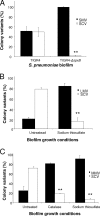Formation of Streptococcus pneumoniae non-phase-variable colony variants is due to increased mutation frequency present under biofilm growth conditions
- PMID: 18658260
- PMCID: PMC2566003
- DOI: 10.1128/JB.00707-08
Formation of Streptococcus pneumoniae non-phase-variable colony variants is due to increased mutation frequency present under biofilm growth conditions
Abstract
In this report, we show that biofilm formation by Streptococcus pneumoniae serotype 19 gives rise to variants (the small mucoid variant [SMV] and the acapsular small-colony variant [SCV]) differing in capsule production, attachment, and biofilm formation compared to wild-type strains. All biofilm-derived variants harbored SNPs in cps19F. SCVs reverted to SMV, but no reversion to the wild-type phenotype was noted, indicating that these variants were distinct from opaque- and transparent-phase variants. The SCV-SMV reversion frequency was dependent on growth conditions and treatment with tetracycline. Increased reversion rates were coincident with antibiotic treatment, implicating oxidative stress as a trigger for the SCV-SMV switch. We, therefore, evaluated the role played by hydrogen peroxide, the oxidizing chemical, in the reversion and emergence of variants. Biofilms of S. pneumoniae TIGR4-DeltaspxB, defective in hydrogen peroxide production, showed a significant reduction in variant formation. Similarly, supplementing the medium with catalase or sodium thiosulfate yielded a significant reduction in variants formed by wild-type biofilms. Resistance to rifampin, an indicator for mutation frequency, was found to increase approximately 55-fold in biofilms compared to planktonic cells for each of the three wild-type strains examined. In contrast, TIGR4-DeltaspxB grown as a biofilm showed no increase in rifampin resistance compared to the same cells grown planktonically. Furthermore, addition of 2.5 and 10 mM hydrogen peroxide to planktonic cells resulted in a 12- and 160-fold increase in mutation frequency, respectively, and gave rise to variants similar in appearance, biofilm-related phenotypes, and distribution of biofilm-derived variants. The results suggest that hydrogen peroxide and environmental conditions specific to biofilms are responsible for the development of non-phase-variable colony variants.
Figures






References
-
- Caimano, M., G. G. Hardy, and J. Yother. 1998. Capsule genetics in Streptococcus pneumoniae and a possible role for transposition in the generation of the type 3 locus. Microb. Drug Resist. 411-23. - PubMed
-
- Coffey, T. J., M. C. Enright, M. Daniels, J. K. Morona, R. Morona, W. Hryniewicz, J. C. Paton, and B. G. Spratt. 1998. Recombinational exchanges at the capsular polysaccharide biosynthetic locus lead to frequent serotype changes among natural isolates of Streptococcus pneumoniae. Mol. Microbiol. 2773-83. - PubMed
MeSH terms
Substances
LinkOut - more resources
Full Text Sources
Other Literature Sources
Molecular Biology Databases

